The Ac in the Aviary Room Is on the Fritz Again. Can You Turn Up the Heat?

What's ac?
Air conditioning is the procedure of removing oestrus/cold and moisture from the interior of an occupied space and oftentimes means equipment used for that process. A common air conditioner uses a mechanical system called a "heat pump" that allows for the transfer of heat between indoor and outdoor units, with the help of a gaseous refrigerant. An air conditioner draws heat from the indoor exchanger and releases it to the outdoor exchanger. When cooling, the compressor inside the outdoor unit liquefies the refrigerant to absorb oestrus. When heating, conversely, heated pressurized gas generated by the heat exchanger and compressor inside the outdoor unit is condensed to heat air in the room. These 2 cycles tin be switched, allowing the organization to provide both cooling and heating
History
The Development of Modern Air Conditioners
How an Air Conditioner Works
What Is Humidity Control?
Applications
Types of Air conditioning Systems
Types of Air Workout Systems -Commercial Ac
Additional Equipment for Air Conditioning
Selecting an Air Conditioner That Best Fits Your Infinite
Controls
The Latest Air-conditioning Features That Increment the Quality of Life
Air Conditioners That Improve the Quality of Indoor Air
Air Conditioning That Is Genuinely Energy-Efficient and Green
Summary
History
Since prehistoric times, ice and h2o were used for cooling. Harvesting ice during winter and storing information technology for utilize in summer used to be a pop concern beyond the globe. The capability of cooling things all year circular that would not require water ice producible merely in wintertime had been what aboriginal people much long dreamed of.
Evaporative Cooling — The Concept behind Air-conditioning Has Been Around Since Ancient Egypt
The bones concept backside today's air conditioning tin can appointment dorsum to ancient Egypt. Frescos painted the 25th century BC testify that people dorsum and then fanning water seeping from fine pores of unglazed pots, cooling the water inside.
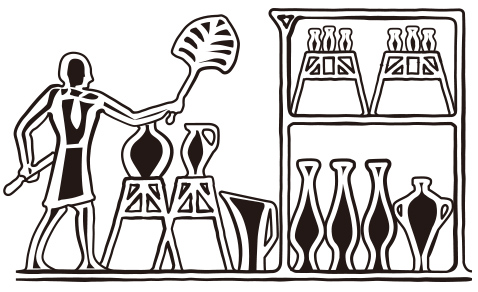
Development of Mechanical Cooling—Modern Ac Emerged from Advances in Chemistry during the 19th Century
In 1758, Benjamin Franklin, an American politician, diplomat, writer, physicist and meteorologist, and John Hadley, a chemical science professor at Cambridge University, explored the principle of evaporation as a means to chop-chop cool an object. Franklin and Hadley confirmed that evaporation of highly volatile liquids (such equally alcohol and ether) could be used to drive down the temperature of an object past the freezing point of water.
In 1820, British scientist and inventor Michael Faraday discovered that compressing and liquefying ammonia could arctic air.
In 1824, Sadi Carnot, a French military engineer and physicist, gave the starting time successful theory of the refrigeration cycle.
In 1834, Jacob Perkins, an American residing in England, invented the first mechanical vapor-pinch refrigeration freezer. Perkins used ethyl ether, repeatedly compressed and expanded manually to produce a refrigeration state.
In 1842, American dr., scientist, and inventor John Gorrie used compressor technology to create water ice, which he used to absurd air for his patients in his hospital. Gorrie was granted a patent in 1851 for his ice-making automobile.

The Advent of Electric Air Conditioning—Made Temperatures and Humidity Controllable
In 1902, the offset modern electric air workout unit of measurement was invented past Willis Carrier in Buffalo, New York. It was designed in response to an air quality problem experienced at a publishing company and was capable of controlling temperature and humidity. Carrier later founded Carrier Air-conditioning Company of America.
In 1906, engineer and contractor Stuart W. Cramer of Charlotte, Northward Carolina, was exploring ways to add wet to the air in his material mill. He combined wet with ventilation to condition and modify the air in factories, controlling the humidity to meet the required level in fabric plants. Cramer is the one known for coining the term "ac."
Development of Safe and Surroundings-Friendly Refrigerants
The refrigerant circulates through the indoor and outdoor units of the air conditioner to carry heat, and cools or warms the indoor air. The outset air conditioners and refrigerators in the early on 20th century employed toxic or flammable gases, such as ammonia, methyl chloride, or propane, that could upshot in fatal accidents when they leaked.
Thomas Midgley, Jr created the get-go cfc gas (Chlorofluorocarbon) in 1928.
Beingness chemically stable, non-flammable, and easily liquefied, fluorocarbons had been in utilize everywhere, every bit, east.g., refrigerants for air conditioners and refrigerators, foaming agents for heat-insulating materials, cleaning agents for precision parts, and droplets propellants.
Withal, ozone depletion came up to the surface as a global issue in the 1970s. CFCs became the culprits mainly responsible for man-fabricated chemical ozone depletion. The Vienna Convention for the Protection of the Ozone Layer signed in 1985 and the Montreal Protocol agreed in 1987 provided frameworks for international reductions in the production and trade of chlorofluorocarbons. These international frameworks encouraged the use of CFC alternatives, such as hydrochlorofluorocarbons (HCFCs) and hydrofluorocarbons (HFCs).
In the 1990s, HCFCs and HFCs were classified into a subset of a larger grouping of climate-changing greenhouse gases (GHGs). And then, the Kyoto Protocol agreed in 1997 set the broad outlines of emissions targets of GHGs.
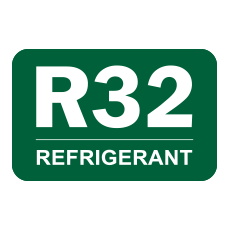

College cooling capacity which increases estrus transfer efficiency.

Consumes less energy, helping you lot to salve on electricity costs.

Zero impact on the ozone layer, thus it's friendlier to the environs.
The Development of Modern Air Conditioners
As technologies advance, modern air conditioners proceed to evolve. In this section, we walk you lot through how future air conditioners will connect to devices via the Net and produce greater condolement with air for improve quality of life.
HVAC Provides a Consummate Suite of Controls for Ventilation, Air conditioning, and Dehumidification
HVAC stands for Heating, Ventilation, and Air Workout. It is environmental comfort technology that plays an essential part of residential structures such as unmarried-family unit homes, apartment buildings, medium to large industrial and function buildings, and vehicles such equally cars, trains, ships, and airplanes.
You might not need more than one air conditioner with a ventilator to cool or oestrus the living space of your house or flat. For larger buildings, however, service designers and mechanical engineers design and specify HVAC systems appropriate to the analyzed requirements and limitations.
The Age of Smart Homes, Where Communication Systems Connect Simply about Every Chemical element of Ac
A smart dwelling house is a residence that uses network-continued devices to enable the remote monitoring and direction of appliances and systems that use IoT (Cyberspace of Things), artificial intelligence (AI) and/or sensing. It provides homeowners condolement, security, and safety by allowing them to command "smart appliances," oft past a smart dwelling house app on their smartphone or other network device. Smart appliances designed to evangelize convenience and improve quality of life are now seen in:
A Full Suite of AC Controls That Are in Your Hand Wherever You Are
Most of the latest air conditioners come with wireless LAN (WLAN) connection capability that offers users smartphone controls over the Net.
For example, bated from being able to switch on the air conditioner remotely before arriving dwelling, Panasonic'due south dwelling house-use air conditioner, "Eolia", adult in Japan, also scans the air quality using dust sensors, then displays information technology on the app. It is installed with a cut edge applied science that foresees future impurities in the air based on the provided data and starts cleaning the air accordingly.

How an Air Conditioner Works
We have seen the history of air conditioning and the latest trends in what modern air conditioners offer. Yet, some may non exist sure how air is heated or cooled. Let'south walk y'all through quickly how an air conditioner works.
Basic Machinery and Principle
The underlying principle of evaporative cooling is the fact that water must have heat, known as the "rut of vaporization", applied to it to alter from a liquid to a vapor. For example, touching rubbing alcohol irritates your finger because it takes oestrus abroad from the skin as the booze evaporates. This represents the principle of evaporative cooling. Conversely, when a gas liquefies, it releases a lot of rut, which is how evaporative heating takes place.
Air conditioners piece of work using these principles. A liquid chosen a "refrigerant" circulates through a closed piping system, repeatedly liquefying and evaporating to absurd air. Reversing the refrigerant flow (reverse cycle) heats air.
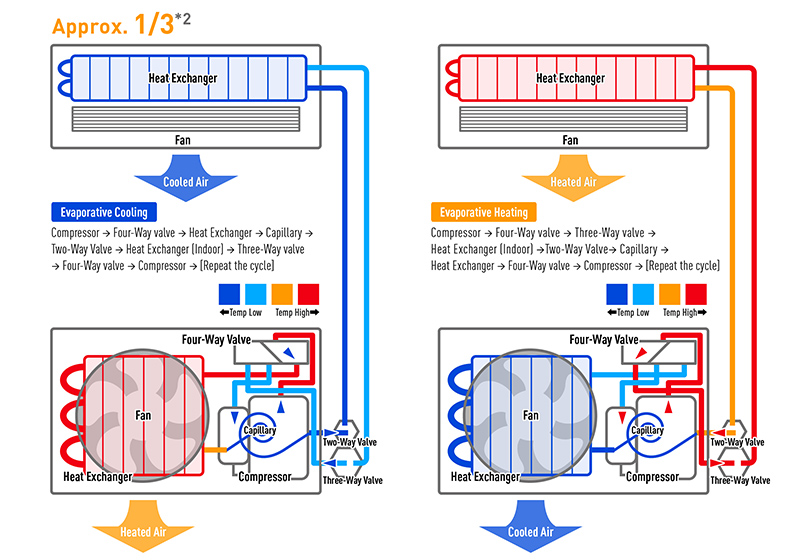
Refrigeration Wheel
Substances change country, i.e., solid, liquid, gas, usually when they are heated or cooled. That is called "irresolute states of affair". Air conditioners leverage the changes in states of refrigerant to cool or heat room air. The refrigeration cycle continuously changes us of a refrigerant circulating in a airtight piping organization.
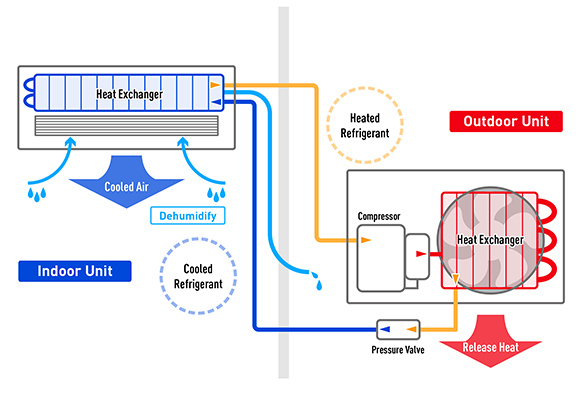
i. Compressing
When the cooling process starts, the refrigerant at low temperature and pressure is compressed by the compressor. The temperature of the gas increases, whereby making the refrigerant gaseous at loftier temperature and pressure.
2. Condensing
The gaseous refrigerant is transferred to the condenser (heat changer), where estrus is exchanged between the refrigerant and outdoor air. This releases the heat of the refrigerant into the outdoor air. Releasing the heat, the refrigerant changes its state to a medium-temperature and high-pressure liquid.
3. Expansion
The liquefied refrigerant moves to the expansion valve that decreases the pressure of the refrigerant. Depressurized refrigerant expands, dropping the temperature and changing its state into a liquid of depression temperature and pressure.
4. Vaporization
The refrigerant turned into a low-temperature and low-pressure liquid at the expansion valve is transferred to the evaporator (heat exchanger), where heat is exchanged between the refrigerant and indoor air. The heat of the indoor air moves to the refrigerant and the air is cooled. The refrigerant picks up the heat from the air, irresolute its state into a low-temperature and low-pressure gas, and goes back to the compressor again.
Contrary Cycle
A heat pump air conditioner uses a four-mode valve that reverses refrigerant menses to offer both cooling and heating for air-conditioned comfort all year circular. This part is referred to as a "reverse bicycle". The term "reverse cycle air conditioner", some other name for a heat pump air conditioner, comes from the mechanism of the cycle.
Compressor
An air conditioner compressor is a component in the system that raises the pressure of the vapor refrigerant to cause changes in the refrigerant temperatures. About home use air conditioners have compressors within their outdoor units.
Estrus Pump
Estrus flows from hot to cold. A estrus pump reverses that menstruation by extracting heat from one place and transfers it to another. Depending on whether the cooling or heating manner is selected, it pumps estrus in and out using the heat wheel of compression, condensation, expansion, and evaporation.
Inverter
A ability inverter, or just, inverter, is an electronic device or circuitry that changes direct current (DC) to alternating current (AC). About domestic and commercial buildings are commonly powered by Ac. Standard voltages and frequencies vary by country. Irresolute frequency or voltage requires an inverter that converts Ac to DC and, afterwards needed changes in frequency and voltage, converts DC back to AC. Air conditioners with inverters run at controllable motor speeds—an efficient way for energy saving.
H2o-Cooled Chiller System
A h2o-cooled chiller organisation has a chiller that uses h2o as the refrigerant and tin be found in many commercial and industrial applications. The water picks upwardly heat within the edifice, returns to the chiller, where it is cooled, so goes back to circulating through the building.
Cooling Belfry
A cooling tower, often located on rooftops, is a oestrus rejection device that helps refrigerated air workout work effectively. Heat commutation taking place in the refrigeration unit increases the temperature of the cooling water. The cooling belfry retains and exposes the water to air fanned into the belfry to allow evaporation, which lowers the water temperature. Then, the h2o is passed back to the refrigerant unit and reused.
Complimentary Cooling
Complimentary cooling is an economical method of using low external air temperatures in winter to assistance in spooky water. The chilled water can be stored until summer and used in the cooling tower to release heat. When the ambient air temperature drops to a set temperature, a modulating valve allows the chilled water to by-laissez passer an existing chiller and run through the free cooling system, which requires much less power to cool the water in the system.
In Europe, free cooling may refer to an exterior air cooling system that uses external air inflows to cool air.
What Is Humidity Control?
Decreased humidity leads to dry air, which causes mucous membrane in the throat to go less immune to flu pathogens and other infections. Too much humidity, on the other paw, causes discomfort. When the humidity of the air increases, it allows the growth of biological contaminants such as mold and mites. The American Lodge of Heating, Refrigerating and Air-Conditioning Engineers (ASHRAE) recommend that indoor relative humidity be maintained betwixt 40-60%.
The Deviation Between Air Conditioners and Dehumidifiers
A lot of air conditioners serve equally dehumidifiers. Air conditioning (cooling) is a office that prioritizes the lowering of room temperatures. So, when the cooling way is selected on an air conditioner, it continues to absurd air until it drops to a set temperature. Dehumidifiers are designed to lower the humidity level of a given space and run a weak cooling mode until the preset relative humidity is reached. Some dehumidifiers can dehumidify and reheat to produce a room environs with drier air without lowering temperatures.
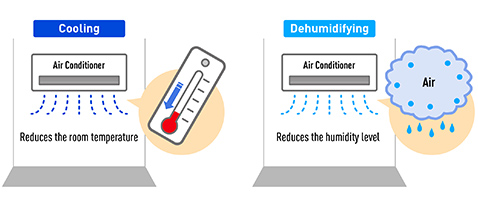
Applications
Air conditioning is most creating desired air environments for occupants or objects inside. Air workout applications are broadly divided into condolement and process applications.
Condolement application

With comfort air-conditioning, the focus is on people living, working, etc., in office buildings, medical facilities, schools, stores, or vehicles.
Unmarried-Family Homes and Low-Ascension Apartment Buildings
Packaged window unit (in-window) air conditioners or split organisation air conditioners are the popular choices for houses and low-ascension apartment buildings. Split up-system air conditioners come in two forms: single-split and multi-divide (fundamental) systems. A single-split system is usually composed of one indoor unit of measurement and one outdoor unit, while a multi-split system has two or more indoor units. The type of system, room size, and functions needed are typical elements to be considered in selecting an air conditioner.
High-Rise Housing, e.g., Condos
The larger the building, the more complex the ac system can be.
Air conditioning systems for high-rise housing are broadly classified into two types by how the heat source is distributed: cardinal heating and distributed heating. A central heating system provides warmth to the whole interior of a edifice from one point (eastward.g., a motorcar room, where all heat sources such as a boiler and refrigeration unit are housed) to multiple rooms. In a distributed heating organisation, heat sources are located at multiple points from which air conditioning for rooms of a floor or zone is provided.
Public Institutions, east.g., Hospitals, Schools
Medical eye or educational institution buildings have spaces with unlike functions, therefore they require specific designs advisable to the purpose of how they are used. For instance, waiting rooms or offices require typical condolement air conditioning, while operating rooms or kitchens have to be designed to meet role-specific requirements.
Office Buildings
Role buildings provide spaces for businesspersons, who can be warm weather condition persons or who adopt temperatures a piffling lower. Airflow directions should exist fabricated selectable for comfort air conditioning. In designing a organisation, straight exposure to drafts from an air conditioner should also be avoided.
Commercial Buildings that Arrange Shopping Malls, Restaurants
Commercial buildings firm varying businesses that require different capacities of air conditioning even when all tenants have the same area. If at that place is a restaurant in the building, ease of maintenance and an oil-trapping filter organization should exist considered in air workout design for its kitchen surface area. For commercial buildings, tenant-axial air conditioning with desirable indoor unit designs and outdoor unit of measurement layouts that offer comfort for customers is an additional requirement.
Industrial Buildings
In improver to comfort, industrial ac pattern may involve cooling equipment for machinery and tooling. Cooling the vast infinite of an industrial facility requires significantly large power output. That is why it is oftentimes recommended to utilize the convenience of spot coolers or fans to reduce the overall power consumption.
Route, Air, and Marine Vehicles for Conveying Passengers or Fresh Produce
Buses, refrigerated vehicles, railways, aircraft, and ships—they all demand air conditioning plans appropriate to the needs of what they conduct. Public vehicles tend to go packed with many people, making it essential to exist well ventilated in improver to controlling the temperature and humidity. For aircraft, motel force per unit area must exist maintained at a abiding level, in order to create a safety and comfortable environment for passengers and coiffure flight at high altitudes.
Process Applications

Process applications aim to provide a suitable surround, due east.g., internal heat and humidity loads, for a process existence carried out, as well as for materials or mechanism existence used for it. Process applications include industrial environments; plants and farm growing areas; food cooking, processing, and storage areas; and ecology command of data centers.
Cleanrooms
A cleanroom is a facility that, as a office of specialized industrial product or scientific research, maintains extremely low levels of particulates, meeting specified cleanliness requirements and when necessary, controllable temperature and humidity levels.
Cleanroom air-conditioning blueprint involves the apply of high-functioning filters to keep airflow circulation and dust levels nether thresholds.
Biological Cleanrooms
Facilities for convenance laboratory animals need to be air-conditioned to special requirements in order to provide an environs for obtaining highly reliable data. Temperature and humidity must be advisedly controlled to levels appropriate to animals being bred. Interior air must meet cleanliness requirements and be properly deodorized.
Information Centers
Air conditioning for information centers needs to suppress oestrus generation from computers and servers, and, at the aforementioned time, distribute conditioned air to accommodate the thermal comfort needs of humans. Capabilities for keeping moderate humidity level and saving energy must exist also factored into the air condition planning.
Operating Theaters
Basic requirements for ac systems in operating theaters include the regulation of temperature and humidity and the air comfort for patients and medical care practitioners. Operating rooms need to have a positive pressure relationship to next areas, i.due east., a pressure within needs to exist kept greater than the surroundings that surrounds the room.
Types of Air Workout Systems
The nomenclature of domicile-utilize air conditioners include:
Window unit of measurement air conditioner
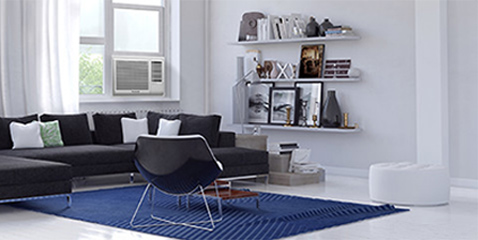
In a window air conditioner, all the components, namely the compressor, condenser, expansion valve or coil, evaporator, and cooling coil are enclosed in a single box package. This unit of measurement is fitted in, usually, a windowsill, eliminating the need for ducting.
Dissever
The dissever air conditioner is comprised of two parts -- the outdoor unit and the indoor unit of measurement -- and comes in unmarried separate or multi carve up configurations.
Single Split System
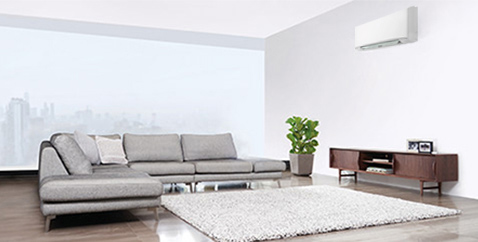
In a single split air conditioner, one outdoor unit of measurement runs the organization to provide conditioned air from an indoor unit of measurement.
Multi Split System
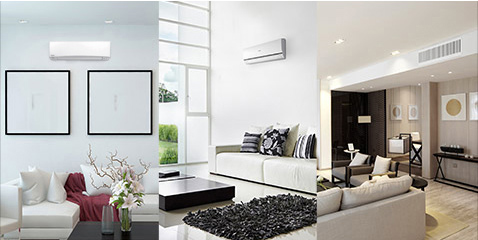
The outdoor unit of measurement of a multi divide air conditioner runs more than i indoor unit of measurement. A popular choice for owners of newly built houses. Considering information technology requires only ane unit outdoor, a multi split organisation contributes to a sleek business firm appearance.
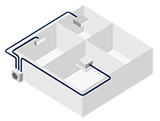
Requirements for Multi Separate System Installation
The following requirements should be taken into consideration.
Piping Routes
A multi divide system needs piping to connect the outdoor unit and multiple indoor units. Dimensional constraints should exist reviewed beforehand to ensure the installation of all piping.
Outdoor Unit Chapters
The full capacity of the indoor units has to exist kept below the chapters of the outdoor unit.
Air-to-Water (AtoW) Heat Pump
An AtoW heat pump traps heat from the air to warm the refrigerant. Like a split system air conditioner, the AtoW system is comprised of an indoor unit of measurement and outdoor unit of measurement. Heated water is stored in a tank inside the indoor unit of measurement and used for showering, drinking, interior air heating or floor heating.
The technology uses heat in the air and has been drawing attending in Europe, where ecology concerns are prompting people to move from conventional combustion boilers to systems that are less impactful on the surroundings.
Aquarea J Generation is a characteristic-packed air-to-water heat pump system mainly for Europe market representing Panasonic's latest technologies.
Types of Ac Systems -Commercial Air-conditioning
Cooling/heating capacity is where commercial/manufacture air conditioning systems significantly differ from residential air conditioners. Commercial/industry air conditioning systems are roughly classified, by their chapters, into those for medium-size offices or stores and those for buildings and large facilities.
Indoor units come in a diversity of types to meet varying requirements that are divers by infinite volume and applications.
Office/Store Ac Systems

Single-Separate Packaged Air Conditioners
In a single split air conditioner, one outdoor unit runs the system that provides conditioned air from an indoor unit.
Multi-Split Packaged Air Conditioners
In a multi split air conditioner, 1 outdoor unit runs more than than one indoor unit of measurement, making it a popular pick for owners of stores and stand-lonely offices.
Packaged Terminal Air Conditioners
A packaged concluding air conditioner (PTAC) is a ductless, self-independent through-the-wall heating and cooling system commonly plant in hotels, housing facilities, and apartment buildings. With indoor evaporation units and outdoor condensation units continued through walls, PTACs are installable in a smaller surface area and provide private air conditioning.
Building/Factory Air Workout System

VRF/Mini VRF
In a variable refrigerant period (VRF) organization, one outdoor unit runs more than one indoor unit. VRFs are typically installed in medium to big buildings bigger than stores or stand-alone offices for which multi-split packaged air conditioners are the popular selection. Being operated at varying speeds, VRF units adjust to the needed rate allowing for substantial free energy savings. Those that come with compact outdoor units designed for modest to mid-size buildings are called mini VRFs.
Gas Heat Pump (GHP) Ac System
A gas heat pump (GHP) air-conditioning system has a gas engine-powered compressor inside the outdoor unit and a heat pump to heat or cool air in living spaces.
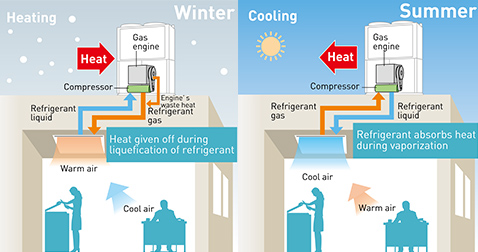
Chiller
A chiller is a machine that removes heat from a liquid via a vapor-pinch or absorption refrigeration bicycle. This liquid called refrigerant is circulated through a heat exchanger to absurd equipment. Chillers are in use for industrial machines and laboratory instruments, to continually maintain optimum temperatures. Commercial buildings and factories as well use chillers for air workout.
Air Handling Unit (AHU)
An air handling unit (AHU) is a device used to regulate and circulate air as part of a heating, ventilating, and ac organization. It uses cold/hot h2o or steam to regulate the temperatures and humidity of the air that flows into living spaces.
Central Air conditioning
In a cardinal air conditioning organisation, a heat source device installed in the building heats the water circulating in the system. The water flows to and from an AHU to provide conditioned air. That is in dissimilarity to individual air conditioning systems that take oestrus sources for each flooring and surface area.
Types of Indoor Units
Indoor units of commercial/industrial air conditioners come in various types, depending on room geometries and applications.

Ducted
Indoor units of a ducted air conditioner are installed in the ceiling infinite. The air inlet or outlet grilles are the only parts visible on the ceiling surface.

Wall-Mounted
The indoor unit is wall-mounted and entirely exposed.
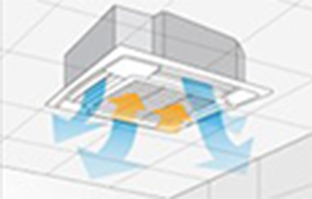
Ceiling Cassette
The indoor unit of a born cassette air conditioner is installed in the ceiling space. The ceiling console is the only part exposed and visible on the ceiling surface. The unit and ducts, being in the ceiling, are less visible and out of the style.

Ceiling-Mounted
The indoor unit is mounted on the ceiling surface and exposed.
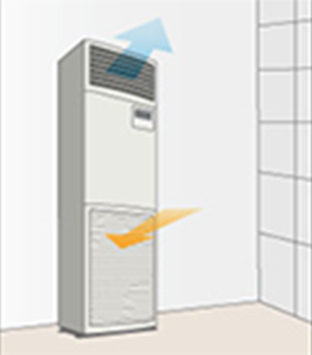
Flooring
Being placed on the floor reduces time required for installation.
Additional Equipment for Air Conditioning
Below are apparatuses that help air conditioners provide amend room air
Air Purifier
An air purifier or air cleaner is a device which removes contaminants, e.g., dust, pollens, house dust, from the air in a room to better the quality of indoor air.
Ventilation Fan
An air conditioner provides cool/hot airflow but does not ventilate. Using fan ventilation, together with an air conditioner, ensures fresh air intake all the fourth dimension.
Fan
Using a fan together with air conditioning boosts the cooling effect without unnecessarily lowering temperature. Fans are also useful to effectively deliver cool air to stuffy spaces.
Heater
It takes time to warm the entire room with an air conditioner in wintertime. Fan heaters increase the heating efficiency of air-conditioning in use.
Selecting an Air Conditioner That Best Fits Your Space
The air conditioning capacity is the commencement element to be factored in when choosing the right commercial air conditioning system for your business.
To determine the chapters required, you may besides demand to accept into account other factors; for instance, is the room facing due south or does it have large windows.
Selection one that all-time fits the size and requirements of the rooms, provides comfort, and saves power.
Controls
Advances in communication technologies let more air-conditioning systems to be network continued. Permit united states walk you through some examples of what recent air conditioners offer.
Wireless LAN (WLAN) and Application Controls
The latest air conditioners come up with wireless LAN (WLAN) connection capability that offers users smartphone controls over the Internet. Yous can plough on your air conditioner while yous are away which enables you to come home to a comfy temperature.
Remote Controls
Nigh air conditioners come with remote controls. They offer features like big display LED, ease-of-use, quick press buttons, and more.
Virtual Personal Assistant (VPA)
A virtual personal banana (also referred to every bit intelligent virtual assistant) is a software amanuensis that can provide answers and perform tasks or services for an individual based on commands or questions. Dialogues with the cease-user leverage natural language processing technologies. Bogus intelligence and voice recognition technologies embedded in the unit enable vocalisation control on air conditioners and other digital devices.
Building Management Organization (BMS)
A building management system (BMS) is a estimator-based control system installed in buildings that mechanically and electronically controls and monitors the edifice systems such as admission control, security systems, burn down systems, lighting, elevators, and air-conditioning.
Smart Cloud
Cloud computing is a form of computing use, typically, the on-demand availability of calculator organization resources, peculiarly data storage and calculating power, without direct active management by the user. It delivers services through network-connected computers (servers) to users' personal computers or smartphones. Today, smart deject services are speedily being developed i after another to bring transformation in modern ac.
1 example is Panasonic's Ac Smart Cloud. It remotely monitors the power consumption levels, capacities, efficiency performances of multiple air conditioning devices in different locations via cloud computing systems. Users have quick and piece of cake admission to the data from their tablets or personal computers to ensure sound operations of the devices, and they are ready 24/7 to answer in the result of a malfunction.
Bluetooth
Bluetooth is a short-range wireless communication technology that allows devices and apparatuses to transmit data or voice wirelessly over a short distance. The technology is the aforementioned one that allows y'all to heed to music being streamed on your smartphone through wireless earphones.
Some recent lighting products and air conditioners equipped with Bluetooth technologies, capable of linking with smartphone apps, are receiving much attention in the market.
Zigbee
Zigbee is a wireless network specification for loftier-level communication protocols for proximity (i.e., personal area) wireless ad hoc network. The technology divers by the Zigbee specification offers limited transfer altitude and speed in commutation for being less expensive and to running on lower power.
Devices supporting Zigbee provide remote controlled home automation for air conditioners, lightings, TVs, screens, defunction and other items.
BACnet
BACnet is a communications protocol for edifice automation and control (BAC) networks. The BACnet protocol provides mechanisms for computerized building automation devices to exchange and monitor information, regardless of the building service they perform according to manufacturer'due south specifications for ac, electricity, or fire extinguishing systems.
Modbus
Modbus is a serial communications protocol originally published by Modicon (now Schneider Electric) for use with its programmable logic controllers (PLCs). It has become a de facto standard communication protocol and is at present a usually available means of connecting building management systems (BMS), boilers, manufacturing machinery, and other industrial electronic devices.
The Latest Air Conditioning Features That Increase the Quality of Life
Air conditioners are busy delivering comfort around the year, in item, during summertime and winter. And so, be a savvy consumer and know what they offer. Let'southward have a look at the latest features available on Panasonic air conditioners.

Fan Speed/Coverage
An air conditioner fan circulates the cooled or heated air in the room. The speed and coverage of the fan touch the cooling/heating efficiency. Air conditioners with variable fan speeds and wide coverage lower/enhance the room temperature quickly.
Operating Modes
Typical operating modes include:
Car:Automatically selects and changes modes to keep the room temperature at the specified level.
Cool:Discharges indoor heat to lower the room temperature.
Heat:Transfers outdoor heat to indoors to warm the room air.
DryDehumidifies the room air. As well cools the room air, but not as effectively every bit the cool manner.
Fan OnlyFlows air into the room to deliver a absurd cakewalk with no heating or cooling.
Eco:Runs the air conditioner while limiting the power consumption.
Man Sensor
Detects the presence of a homo body in an area and directs cool or warm wind in that direction. Increases air conditioning efficiency and helps reduce power consumption.
ECONAVI, a total spectrum of Panasonic'south latest technologies, includes sensor analysis on how the room occupant feels the temperature (i.due east., hot or cold), sunlight changes, furniture/room layout, to deliver personalized air conditioning.
Air Filtering & Autonomous Cleaning
Mod air conditioners have sophisticated air filtering capability to remove dust, mould, and bacteria that could be harmful to human being health.
Many air conditioners make clean the inside of units apart and suppress grit pile-upward or mould growth. These functions go on air conditioner filters clean around the clock, reducing ability loss, thus, efficiently reducing your electricity bills.
Night Mode
Dark style in an air conditioner usually refers to a low power mode in which auto-temperature command and air current flow saving are activated for condolement when the user is sleeping. In one case turned on, yous tin can sleep peacefully with no worries well-nigh your room condign too dank or warm.
Bending-Adjustable Louver Slats
Because of convection where common cold air moves down, and warm air rises, air circulates efficiently when louver slats on the forepart of air conditioners are turned upward during cooling and downward when heating. Most models have bending adjustment controls for louver slats on their remote controllers. Sideway bending aligning helps deliver cool/warm air to a particular spot in the room.
Delayed Restart
Delayed restart prevents restart right after an air conditioner is turned off to protect the compressor.
Demand Response Enabling Device (DRED)
As the awareness of global warming grows, demand response, a cap on the ability consumption of an electric utility customer to avoid peaks in need for ability and maintain balance with the supply, is condign a popular option for ability consumption control across the globe. Commonwealth of australia has national standards for Demand Response (Equally/NZS 4755 series) on DREDs. This arrangement has been implemented nationwide by electricity distributors. Voluntary rationing for air conditioners and other electrical appliances is encouraged by way of price incentives.
Motorcar-Defrost
When an air conditioner is run under low outdoor temperatures and high humidity, frost may form on its outdoor unit of measurement. Over time, an accumulation of ice can form on the cooling chemical element (evaporator coil). Eventually, this can block the circulation of the cold air. This is why defrosting is required. Auto-defrost regularly defrosts the evaporator by melting the frost and discharges the resulting water out of the indoor unit.
Air Conditioners That Improve the Quality of Indoor Air
The average adult inhales and exhales near every bit much as xviii kg of air a day. That suggests the quality of air matters for everyone's wellness and comfort.
In recent years some social and health issues have been attributed to pollutants invisible to the naked eyes, e.g., pollens, PM2.5, house grit. Let's meet what air-conditioning can offer by improving the quality of indoor air.
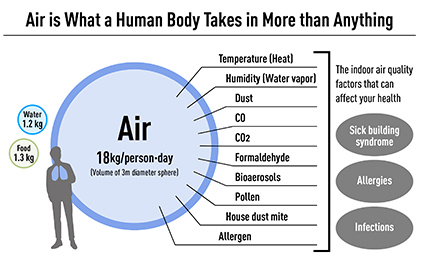
PM2.5 Particles and Other Unhealthy Pollutants
Pollens such as Japanese cedar and Japanese cypress pollens are allergens that trigger allergic rhinitis, conjunctivitis, and/or asthma.
Particulate affair (PM) 2.v is defined as the fraction of particles in the air, with an aerodynamic diameter smaller than two.v µm that can crusade health hazards. Panasonic air conditioners with high-operation filters, east.thousand., dense HEPA filter, are constructive at removing PM2.5.
What is PM2.5?
In recent years, some cities in Northern China and South Asia have had very high levels of particulate matter concentrations, raising health concerns amid neighboring countries. The particle size is small plenty to penetrate deep inside human lungs, and studies evidence exposure to high concentrations of PM2.v can increase the take chances of respiratory and cardiovascular diseases including asthma and bronchitis.
Other Pollutants: PM10, Carbon Monoxide, Sulfur Dioxide, Nitrogen Dioxide
Particles on the gild of x μm or less are called PM10 (or coarse particulate thing). The sources are soot, yellow sand, fibroid particulates and exhaust gases from diverse industrial processes, too as volatile components from petroleum in the atmosphere. Like PM2.5, direct inhalation of PM10 causes respiratory diseases.
Carbon monoxide is produced from the partial oxidation of carbon-containing compounds, such equally when operating gas or fuel run equipment that uses combustion for heating. It is a colorless, odorless, flammable gas and is toxic to animals that use hemoglobin as an oxygen carrier. Exposure to a high level of carbon monoxide may consequence in seizure, coma, and fatality.
Sulfur dioxide is a toxic gas produced as a by-production of the burning (oxidization) of fossil fuels, eastward.chiliad., coal, rough oil, that are contaminated with sulfur compounds. Iron ore and copper ore besides comprise sulfur, therefore, atomic number 26 or copper refining produces sulfur dioxide. Exposure to a high level of sulfur dioxide could result in fatality.
Nitrogen dioxide typically arises via the atmospheric oxidation of nitric oxide (NO) which comes from loftier-temperature combustion of fuels. High concentrations of the gaseous form of nitrogen dioxide cause distress, including irritation of the pharynx, bronchitis or pneumonia. Human-acquired sources of nitrogen dioxide vary. Internal combustion engines, industrial processes, thermal ability plants, domestic heaters or stoves that burn down fossil fuels all produce nitrogen dioxide.
The Better the Indoor Air Quality, the More than Comfy and Healthy Your Life Is.
As mentioned to a higher place, air pollutants human being eyes can't come across are everywhere. Revitalize your air with Panasonic air conditioning. A full spectrum of technologies delivers filtered air for your health, traps and reduces many types of pollutants and allergens like pollens and particulate matters.
Air Conditioning That Is Genuinely Free energy-Efficient and Green
Air Workout Impacts the Global Environment
Common ac refrigerants, such as CFCs and HCFCs, contribute to ozone depletion and climate change. Governments mandate the drove of CFCs/HCFCs upon repair or disposal of air conditioners to forbid refrigerant leakage.
Big power-consuming air conditioners contribute to global warming, since air conditioning units run on electricity that relies primarily on fossil fuels to generate power.

Power Consumption and Efficiency
Air-conditioning requires a lot of electricity. In Europe, the utilize of renewable energies is on the ascension, simply Red china and other Asian countries lag backside. These nations still rely much on thermal power generation, namely, big quantities of oil and coal are combusted. The carbon dioxide emissions from called-for fossil fuels for power generation represent the almost prominent source of greenhouse gas, causing global warming.
Selecting energy-efficient air conditioning for residential, commercial, and industrial applications helps protect environments on a global scale.
Greener Refrigerants
Refrigerant circulates through the indoor and outdoor units of an air conditioner to comport heat. Fluorocarbons, especially chlorofluorocarbons (CFCs), were commonly used refrigerants for decades, but they are existence phased out because of their ozone depletion effects that came up to the forefront equally a global issue in the 1970s. The Vienna Convention for the Protection of the Ozone Layer signed in 1985 and the Montreal Protocol agreed in 1987 provided frameworks for international reductions in the production and merchandise of chlorofluorocarbons. These international frameworks encouraged the utilise of CFCs alternatives, such as hydrochlorofluorocarbons (HCFCs) and Hydrofluorocarbons (HFCs).
In the 1990s, HCFCs and HFCs were classified into a subset of a larger group of climate-changing greenhouse gases (GHGs). Then, the Kyoto Protocol agreed on in 1997 gear up the wide outlines of emissions targets of GHGs.
Difluoromethane, or R-32, used as a refrigerant has depression global warming potential (GWP), therefore, is the preferred substitute today for CFCs and HCFCs. Inquiry on refrigerants that are less impactful than R32 are underway around the world.
What is EER?
The energy efficiency ratio (EER) of an air-conditioning device is the ratio of hourly output cooling free energy (in BTU) to hourly input electrical energy (in watts) at a given operating indicate. A higher EER means the ac system is more efficient.
What is COP?
The coefficient of performance or COP (sometimes CoP) of an air conditioning system is the ratio of useful heating or cooling in proportion to the work required, representing the system's energy consumption efficiency.
The output heat comes from both the heat source and one kWh of input energy.
What is SEER?
The seasonal energy efficiency ratio (SEER) is the efficiency of an air conditioner during a given period (up to 12 months). Like EER, a higher SEER rating means the air conditioning system is more efficient.
SEER Calculation
The SEER rating of a unit is the cooling output during a typical cooling flavour (12 months max) divided by the total electric energy consumption during the same period.
Summary
Air conditioning is now a vital function of our life. People get cool in summertime and warm in the winter with air conditioners.
Air conditioning products pursue more convenience and energy saving at the aforementioned time equally Net connectivity and AI technologies evolve. Challenges remain in the use of CFCs/HCFCs, and guild'southward demand for more free energy-efficient products.
Protecting the global environment and bringing comfort and wellness to people's lives are currently vital missions for air conditioner manufacturers.
Source: https://www.panasonic.com/global/hvac/air-conditioning/about_ac/whats_ac.html
0 Response to "The Ac in the Aviary Room Is on the Fritz Again. Can You Turn Up the Heat?"
Post a Comment